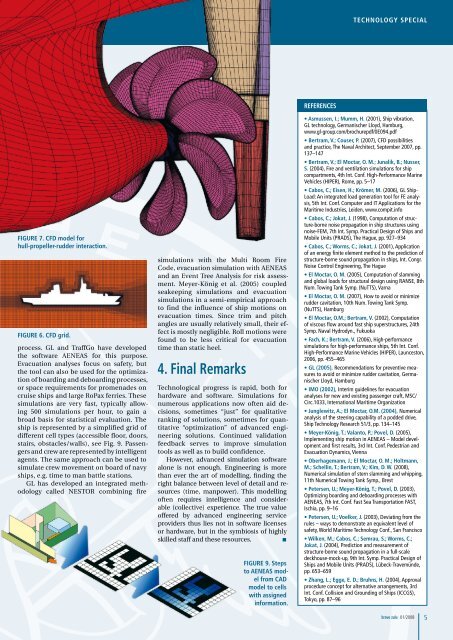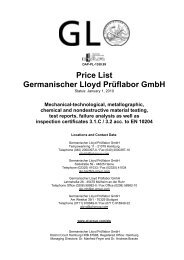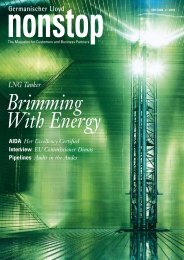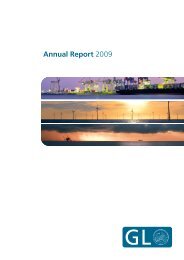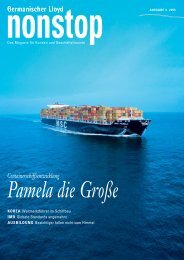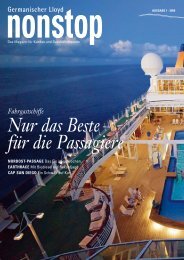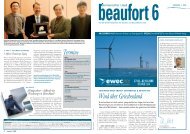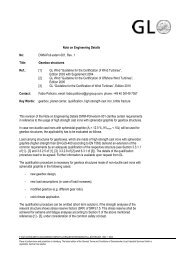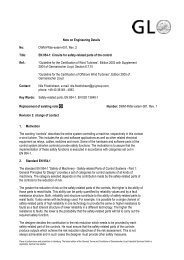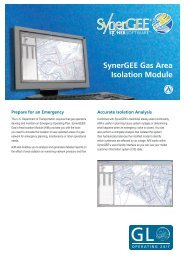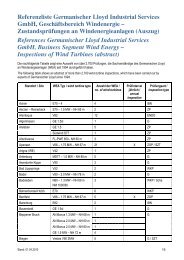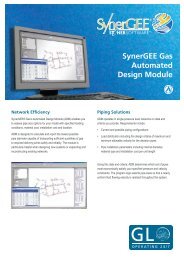bravo zulu 1/2008 - GL Group
bravo zulu 1/2008 - GL Group
bravo zulu 1/2008 - GL Group
Create successful ePaper yourself
Turn your PDF publications into a flip-book with our unique Google optimized e-Paper software.
FIgURE 7. cFd model for<br />
hull-propeller-rudder interaction.<br />
FIgURE 6. cFd grid.<br />
process. <strong>GL</strong> and TraffGo have developed<br />
the software AENEAS for this purpose.<br />
Evacuation analyses focus on safety, but<br />
the tool can also be used for the optimization<br />
of boarding and deboarding processes,<br />
or space requirements for promenades on<br />
cruise ships and large RoPax ferries. These<br />
simulations are very fast, typically allowing<br />
500 simulations per hour, to gain a<br />
broad basis for statistical evaluation. The<br />
ship is represented by a simplified grid of<br />
different cell types (accessible floor, doors,<br />
stairs, obstacles/walls), see Fig. 9. Passengers<br />
and crew are represented by intelligent<br />
agents. The same approach can be used to<br />
simulate crew movement on board of navy<br />
ships, e.g. time to man battle stations.<br />
<strong>GL</strong> has developed an integrated methodology<br />
called NESTOR combining fire<br />
simulations with the Multi Room Fire<br />
Code, evacuation simulation with AENEAS<br />
and an Event Tree Analysis for risk assessment.<br />
Meyer-König et al. (2005) coupled<br />
seakeeping simulations and evacuation<br />
simulations in a semi-empirical approach<br />
to find the influence of ship motions on<br />
evacuation times. Since trim and pitch<br />
angles are usually relatively small, their effect<br />
is mostly negligible. Roll motions were<br />
found to be less critical for evacuation<br />
time than static heel.<br />
4. Final Remarks<br />
Technological progress is rapid, both for<br />
hardware and software. Simulations for<br />
numerous applications now often aid decisions,<br />
sometimes “just” for qualitative<br />
ranking of solutions, sometimes for quantitative<br />
“optimization” of advanced engineering<br />
solutions. Continued validation<br />
feedback serves to improve simulation<br />
tools as well as to build confidence.<br />
However, advanced simulation software<br />
alone is not enough. Engineering is more<br />
than ever the art of modelling, finding the<br />
right balance between level of detail and resources<br />
(time, manpower). This modelling<br />
often requires intelligence and considerable<br />
(collective) experience. The true value<br />
offered by advanced engineering service<br />
providers thus lies not in software licenses<br />
or hardware, but in the symbiosis of highly<br />
skilled staff and these resources. ■<br />
FIgURE 9. Steps<br />
to aEnEaS model<br />
from cad<br />
model to cells<br />
with assigned<br />
information.<br />
REFEREncES<br />
TEchnology SpEcIal<br />
• asmussen, I.; mumm, h. (2001), Ship vibration,<br />
<strong>GL</strong> technology, Germanischer Lloyd, Hamburg,<br />
www.gl-group.com/brochurepdf/0E094.pdf<br />
• Bertram, V.; couser, p. (2007), CFD possibilities<br />
and practice, The Naval Architect, September 2007, pp.<br />
137–147<br />
• Bertram, V.; El moctar, o. m.; Junalik, B.; nusser,<br />
S. (2004), Fire and ventilation simulations for ship<br />
compartments, 4th Int. Conf. High-Performance Marine<br />
Vehicles (HIPER), Rome, pp. 5–17<br />
• cabos, c.; Eisen, h.; Krömer, m. (2006), <strong>GL</strong> Ship-<br />
Load: An integrated load generation tool for FE analysis,<br />
5th Int. Conf. Computer and IT Applications for the<br />
Maritime Industries, Leiden, www.compit.info<br />
• cabos, c.; Jokat, J. (1998), Computation of structure-borne<br />
noise propagation in ship structures using<br />
noise-FEM, 7th Int. Symp. Practical Design of Ships and<br />
Mobile Units (PRADS), The Hague, pp. 927–934<br />
• cabos, c.; Worms, c.; Jokat, J. (2001), Application<br />
of an energy finite element method to the prediction of<br />
structure-borne sound propagation in ships, Int. Congr.<br />
Noise Control Engineering, The Hague<br />
• El moctar, o. m. (2005), Computation of slamming<br />
and global loads for structural design using RANSE, 8th<br />
Num. Towing Tank Symp. (NuTTS), Varna<br />
• El moctar, o. m. (2007), How to avoid or minimize<br />
rudder cavitation, 10th Num. Towing Tank Symp.<br />
(NuTTS), Hamburg<br />
• El moctar, o.m.; Bertram, V. (2002), Computation<br />
of viscous flow around fast ship superstructures, 24th<br />
Symp. Naval Hydrodyn., Fukuoka<br />
• Fach, K.; Bertram, V. (2006), High-performance<br />
simulations for high-performance ships, 5th Int. Conf.<br />
High-Performance Marine Vehicles (HIPER), Launceston,<br />
2006, pp. 455–465<br />
• gl (2005), Recommendations for preventive measures<br />
to avoid or minimize rudder cavitation, Germanischer<br />
Lloyd, Hamburg<br />
• Imo (2002), Interim guidelines for evacuation<br />
analyses for new and existing passenger craft, MSC/<br />
Circ.1033, International Maritime Organization<br />
• Junglewitz, a.; El moctar, o.m. (2004), Numerical<br />
analysis of the steering capability of a podded drive,<br />
Ship Technology Research 51/3, pp. 134–145<br />
• meyer-König, T.; Valanto, p.; povel, d. (2005),<br />
Implementing ship motion in AENEAS – Model development<br />
and first results, 3rd Int. Conf. Pedestrian and<br />
Evacuation Dynamics, Vienna<br />
• oberhagemann, J.; El moctar, o. m.; holtmann,<br />
m.; Schellin, T.; Bertram, V.; Kim, d. W. (<strong>2008</strong>),<br />
Numerical simulation of stern slamming and whipping,<br />
11th Numerical Towing Tank Symp., Brest<br />
• petersen, U.; meyer-König, T.; povel, d. (2003),<br />
Optimizing boarding and deboarding processes with<br />
AENEAS, 7th Int. Conf. Fast Sea Transportation FAST,<br />
Ischia, pp. 9–16<br />
• petersen, U.; Voelker, J. (2003), Deviating from the<br />
rules – ways to demonstrate an equivalent level of<br />
safety, World Maritime Technology Conf., San Francisco<br />
• Wilken, m.; cabos, c.; Semrau, S.; Worms, c.;<br />
Jokat, J. (2004), Prediction and measurement of<br />
structure-borne sound propagation in a full-scale<br />
deckhouse-mock-up, 9th Int. Symp. Practical Design of<br />
Ships and Mobile Units (PRADS), Lübeck-Travemünde,<br />
pp. 653–659<br />
• Zhang, l.; Egge, E. d.; Bruhns, h. (2004), Approval<br />
procedure concept for alternative arrangements, 3rd<br />
Int. Conf. Collision and Grounding of Ships (ICCGS),<br />
Tokyo, pp. 87–96<br />
<strong>bravo</strong> <strong>zulu</strong> 01/<strong>2008</strong>


